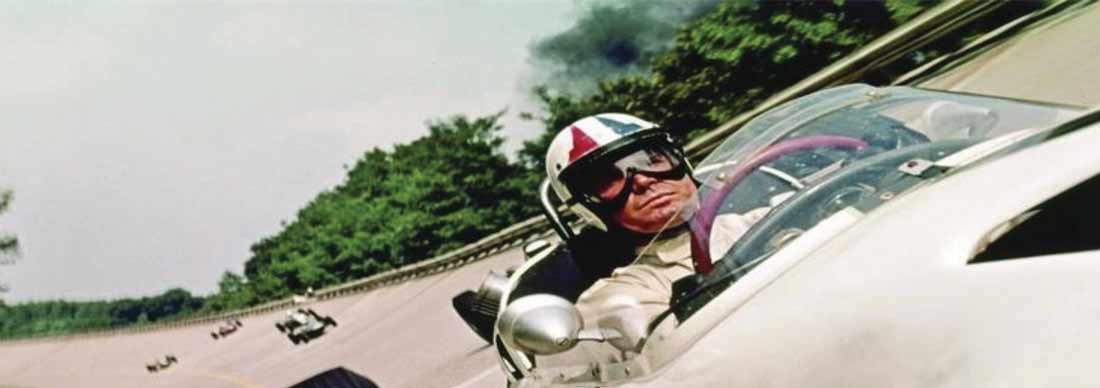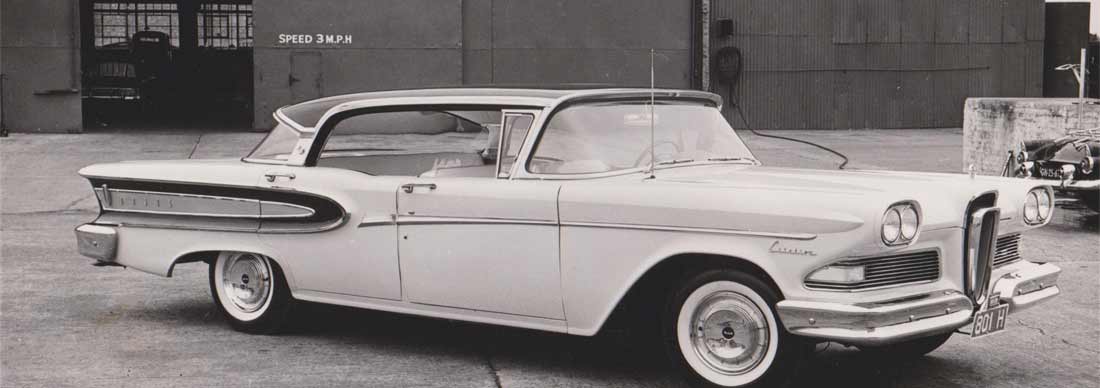
Maverick The Car Thief - Part 2, by Mark Cole
Read Maverick The Car Thief - Part 1
Mark Cole continues his fascinating story of actor James Garner and the making of the iconic motor racing movie - Grand Prix
Frankenheimer’s filming at Monaco concluded with a spectacular set-piece crash between the BRM teammates, Stoddart hitting a cliff face and Aron ending up in the harbour. At that point, BRM fired him, and he was picked up by Japanese car owner Izo Yamura (played by Toshiro Mifune of Seven Samurai fame), to drive for his Honda lookalike team.
At that moment came the news that Warners was dropping its movie, conceding that there was no point in releasing two F1 features at the same time. McQueen, who had sold the idea to Warner, was furious and did not speak to his Californian neighbour Garner for the next two years.
Next race was Spa, where the script called for rain, as it was a wet race – but the following week the Ardennes forests were bathed in sunshine. ‘We had to get in the local fire brigade to provide the spray for our racing scenes,’ recalled Garner. ‘They were none too careful where they directed it, and we all got soaked through. But at Brands Hatch I could have used them when I caught fire…’
Garner’s ‘BRM’ was rigged up to catch alight as he crossed the finish line of the British Grand Prix. ‘We had two switches, one which fired a gas jet at the rear of the car, and the other alongside the cockpit, which I was to fire once I had got out. But it was a US-type switch, which you flick upwards for on, and I caught it before I had got out. I nearly got roasted, but for the cameramen pulling me out.’
The film’s insurers, Lloyds of London, were already concerned that he was doing his own driving at 200 km/h in the rain. So, after the fire they refused to cover him altogether, and he had to complete the movie uninsured.
There was, of course, rivalry between the stars once they became more used to their race cars, and on one occasion Garner and Montand – who was still very much a rookie – were to drive for a couple of laps with an American TV news camera car behind them to publicise the movie.

Above: The Grand Prix movie poster, Garner leading the Monza GP in the ‘Yamura’
‘I told Yves that I would lead into the first corner,’ said James, ‘then he could tuck in behind me. But he made a storming start and I never caught up with him. I was a little pissed because I was the American, but it was quickly forgotten and we stayed good friends.’
One of the film’s best scenes is a drivers’ meeting at Spa, where the fledgling Grand Prix Drivers Association is discussing whether or not they race at Spa in the wet. ‘Yves and I were the actors, but we were upstaged by Graham Hill, Phil Hill, Richie Ginther and Bruce McLaren: they had such charisma,’ Garner remembered. ‘But we all worked well together, there was no “them and us”, and our film crews were great too. Some of our scenes were shot from helicopters, and I remember one cameraman coming back with his shoes and pants stained green from brushing against trees!’
By the time they got to Monza – having filmed further footage at Zandvoort and Clermont-Ferrand (which stood in for Reims, where that year’s French GP actually took place) – Montand’s character was to be killed off in the Italian GP finale to the film, which used the old banking, redundant since Wolfgang von Trips’s death in 1961.

Above: Yves Montand in the ‘Ferrari’ at Clermont-Ferrand
Here Frankenheimer and Russell very nearly fell out – the director wanted to show 7000 rpm on Sarti’s ‘Ferrari’, and asked Russell to change the modified rotor arm. Montand promptly blew the engine: 8000 rpm was showing on the tell-tale when the car was brought back to the pits...
The film premiered in 70mm Cinerama in London in December 1966, after a remarkably short production period of just three months: Frankenheimer’s editors and sound crews had worked on the movie through the season, race on race. For their troubles, they won three OSCARs, for Best Editing, Best Sound and Best Sound Effects.
Garner was not at all worried that neither he nor his co-stars were in the running for Academy Awards. ‘We had a whole year of fun mixing it with Formula 1 stars in beautiful cars, and racing ourselves, and it is right that others got the bigger credit.’
Frankenheimer highlighted that when he told an American journalist, ‘to weigh it all up: the stars costs thousands of dollars, and the cars cost thousands of cents, but the cars were the stars.’
Not all the stars had enjoyed the racing, however. Bedford never got to grips with driving a single-seater, and Montand struggled. Garner, on the other hand, proved competent enough that his interest in racing was fired as a direct result of his involvement in the film. While others had stand-ins, Big Jim did many of his own stunts, ‘Although I let a dummy dive into the Monte Carlo harbour (something both Albert Ascari and Paul Hawkins had done in earlier Monaco grands prix) - I wasn’t that stupid.’
Although he would go on to make further TV series, he never starred in another movie with the stature of Grand Prix. Whilst critically acclaimed for its realism, and a box-office success – it was the 10th highest grossing film of 1967 - some believe it damaged his movie career.
He did, however, move on to make The Rockford Files, a modern-day Maverick-style detective TV series, which ran for six seasons until, ‘I had constant knee problems, aggravated by my insistence on doing my own stunts.’
When Universal Studios axed the series, he sued them for $16.5 million for ‘creative accountancy’, a phrase which his lawsuit invented, but one now is in everyday use. He settled for an undisclosed sum in 1989. For his TV work, he received seven Emmies and Golden Globes.
Post-movies, his talents on the track became strong enough that even Graham Hill remarked that the actor could have been a successful Grand Prix driver if he had not gone into making films. Director Frankenheimer himself agreed.
‘He was a fantastic gentleman,’ said Bob Bondurant. ‘For Grand Prix we trained at Willow Springs race track for five days, trained with several of the actors. We started in Mustang GT350s, then moved to single-seaters. Jim was the best guy by far. He loved it. I looked over at him as we were going side-by-side down the straight there at Willow and he was laughing, he was having such a great time.’
The Bob Bondurant School of High Performance Driving opened in early 1968 at Orange County International Raceway, then moved to Ontario and later to Sears Point, where he was an important figure in the track's development. Datsun was his partner in his school from its beginning.
He joined Garner, together with Dick Guldstrand, to form American International Racing (AIR) to run Corvettes in the 1968 Daytona 24 Hours, Sebring 12 Hours and at Le Mans, but there were so many problems that after Daytona the two blue L88s were replaced by Lola T70s, but again neither finished. The team also fielded a Surtees Formula F5000 car in late 1969 that was featured in the documentary The Racing Scene, starring Garner as himself.
‘I would have loved to have carved out a second career on the track,’ said Garner, ‘but my determination to race was exceeded by my insurers’ determination that I did not.’ Like Steve McQueen, however, they would allow him to race off-road, and he drove a Meyers Manx dune buggy in a Las Vegas desert race in 1968, with AIR Corvette racer Scooter Patrick as his co-driver. The pair finished the gruelling Baja 1000 in a Vic Hickey-built Olds V8 4x4 named “The Grabber”. Then in 1972 he won the Riverside Grand Prix off-road race. In 1978, James Garner was inducted into the Off-Road Motorsports Hall of Fame.
Garner stayed interested in racing his whole life, driving the pace car at the Indy 500 three times, in 1975, ’77 and ’85. His 58-year marriage to Lois Fleishman Clarke was one of Hollywood’s longest unions, longer even than Paul Newman’s 50 years with Joanne Woodward.
Having first met Garner in Japan, I made a Grand Prix retrospective documentary for BAR Honda with 'Pete Aron' on the old Monza banking in 2000, and even at 72, with The Rockford Files long behind him, he was as enthusiastic as ever about four wheels.
We talked about the golden days of F1. ‘I was working with some of the greatest drivers the sport has known,’ he said. ‘Even Juan Manuel Fangio was in the movie, and I made friends with people like Graham Hill, Phil Hill, Bruce McLaren, Jack Brabham, Dan Gurney, Jo Bonnier, Jim Clark, and many more. It was a golden, glorious time. I felt like a shy schoolboy meeting such giants.’
The final shot of our Monza documentary was of ‘Pete Aron’ walking the walk – a little stiffly by now - down the deserted pit straight of the Cathedral of Speed, echoing the final, haunting sequence of Grand Prix where the ghosts were already closing in around the 1966 world champion.
He died in 2014, having suffered further ill-health following by-pass surgery in 1988, and a stroke in 2008.
Paying tribute to him, Clint Eastwood – who after Maverick had played opposite him in the movie Space Cowboys - said, ‘James Garner opened the door for people like Steve McQueen and myself’. Autoweek, the influential American publication, added that he was, ‘A lifelong racing enthusiast who might have really gone places in motorsports if his acting career hadn’t kept getting in the way.’
Books by Mark Cole
Other blog posts by Mark Cole:
Maverick The Car Thief - Part 1






1 comment
My appreciation to Mark Cole on his brief but interesting two-part article on JSG or Jim as I call him, and the making of Grand Prix, still the best racing movie ever made. As a life-long fan of James Garner as well as having an interest in anything automotive I’m always interested in seeing the two together and immensely proud of the work he did in that film as well as keeping me entertained for fifty years. Many thanks
S. Carter
Leave a comment
This site is protected by hCaptcha and the hCaptcha Privacy Policy and Terms of Service apply.